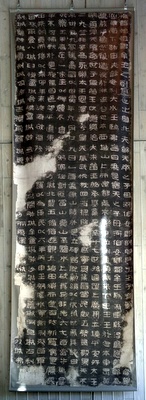King Gwanggaeto (lit. "king who broadly opened the territory") was the 19th ruler of the ancient Korean kingdom of Koguryo. He is known for leading the kingdom into a great revival and expanding its territory after a period of defeats against outside attackers.
A stele associated with him was discovered in the city of Jí'ān in China's Jilin province near the China-Korea border in 1880. It was inscribed and erected by his son and successor, King Jangsu of Koguryo, detailing the accomplishments of his father. The roughly 1800-character text is of particular note as it is an early example of a text referring to Japan as wa (倭). The stele is inscribed on four sides; rubbings of all four sides are held in the collection of the Tôyô Bunko.
References
- Gallery labels, Tôyô Bunko.[1]
